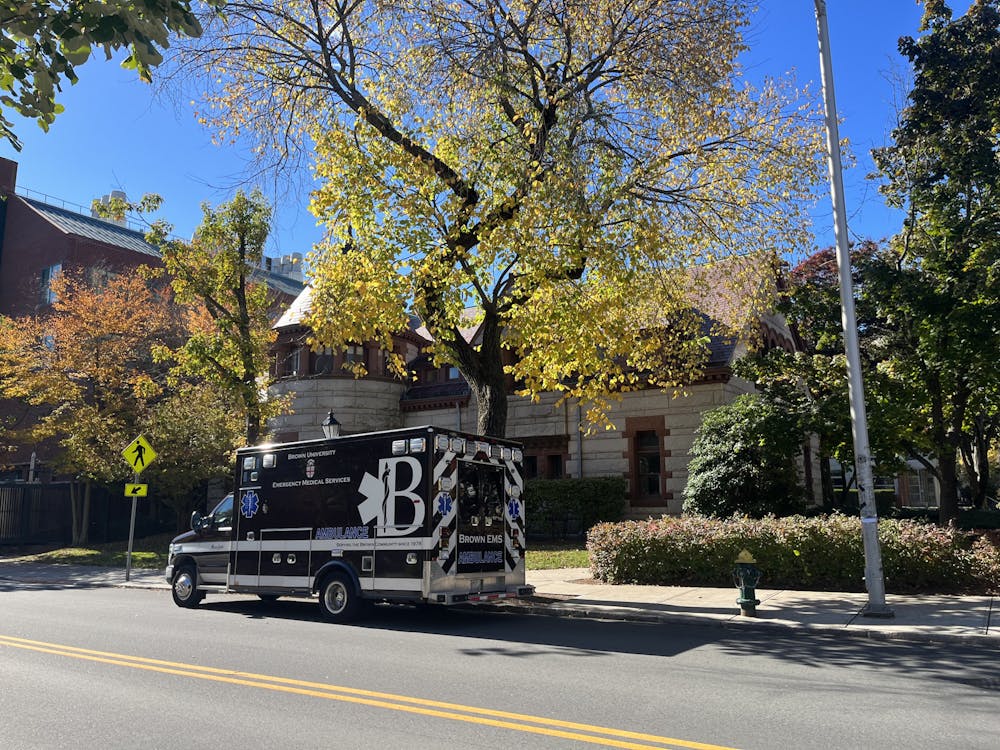Founded in 1978, Brown Emergency Medical Services serves the Brown community as a paid and volunteer ambulance service, offering free emergency prehospital care. According to their website, BEMS “is primarily staffed by Brown students who are licensed prehospital providers including EMTs, advanced EMTs and paramedics.”
In addition to emergency services, BEMS provides medical services at campus events, offers CPR workshops for community members and operates the Wellness Wagon, a non-emergency vehicle that transfers students to and from medical appointments around Providence, according to Julia Villani ’24 and former Herald senior staff writer Jasper Yeh ’24, BEMS student co-directors.
Currently, BEMS consists of three full-time staff members, 39 active student ambulance EMTs — emergency medical technicians — and 17 student first-responders, along with a handful of graduate and professional staff supervisors.
BEMS is also in the process of an expansion: According to Andrew Tetreault, training and performance officer at BEMS, the organization is currently onboarding 44 students to their ambulance team.
BEMS is changing the way it recruits student volunteers, Tetreault said. While it previously followed a once-a-year recruitment cycle in the fall, the organization is shifting to “as needed” onboarding of student volunteers in response to shifting “personnel needs and the needs of the University.”
According to Yeh and Villani, student shifts for BEMS consist of two six-hour day shifts and a 12-hour overnight shift. When on their shift but not actively responding to a call, students engage in practical training, skill refreshers and additional administrative tasks at BEMS’s headquarters in the Health and Wellness Center. For those working an overnight shift, volunteers have a bunk room to sleep in.
“When we are dispatched, we drop what we’re doing and respond to the call,” Yeh and Villiani wrote in an email to The Herald. “During overnight shifts, the radio is definitely loud enough for us to immediately wake up and respond.”
They added that each shift is staffed with one supervisor, either a hired professional staff member or an experienced student EMT, along with one to three students — all of whom are licensed EMTs.
Having student volunteers respond to emergency calls across Brown’s campus “allows much easier connection between patient and caregiver,” Tetreault said. He emphasized the importance of student volunteers in fulfilling the mission of BEMS, noting that the organization is powered by “students wanting to serve the Brown community.”
“I really wanted to work for BEMS because it felt like a fantastic way to give back to the Brown community,” Yeh wrote. “(Volunteering) made me feel like I have a deeply personal stake in contributing to the health and well-being of Brown students and staff.”
“My favorite thing is just getting to know the people that I’m taking care of and feeling like I’m doing something for Brown students,” said Clara Lee Molina ’25, a volunteer EMT.
Lee Molina added that she joined BEMS in part because of her own experience having to call BEMS as a first-year. “I was treated by some really lovely people,” she said.
For student volunteers interested in working on the ambulance, Tetreault explained that students must obtain an EMT certification in Rhode Island, which BEMS offers as a summer course. Students are also required to go through department-specific training, where they learn how to operate BEMS ambulance equipment.
Tetreault added that some volunteer positions at BEMS do not require an EMT license, such as working as a first-responder on the Wellness Wagon.
Lee Molina emphasized the education she has gained through BEMS. “I learned a lot about teamwork and genuinely having to be able to communicate well with people in super high-stress situations,” Lee Molina said. “Being able to keep my composure and look out for my crew, for my patients in a difficult situation … that’s really important.”
Saadhya Bahudodda ’24, a volunteer EMT, said that working with BEMS allowed her to become “more comfortable in my skills and more confident as a patient provider.”
But students also noted the challenges that they have faced on the job, including the difficult nature of the situations they respond to.
“I think it can be challenging depending on what kind of calls you get,” Bahudodda said. “You are working with students and people that you know, and a lot of times that can be hard if you see them in a particularly vulnerable state.”
“The most difficult calls for me are those that are highly emotional for the patient,” Yeh wrote. “There’s a general consensus that this work can be really difficult but it is also incredibly rewarding. As BEMS student volunteers, we have a unique opportunity to serve a community that we also belong to.”
Jennifer Shim was a University News editor at The Herald.





